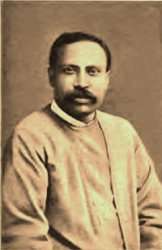Sarat Chandra Das
| Sarat Chandra Das শরৎচন্দ্র দাস | |
|---|---|
|
Sarat Chandra Das | |
| Born |
1849 Chittagong, Bengal, British India |
| Died | 1917 |
| Nationality | British India |
| Occupation | Explorer, Scholar |
| Religion | Hinduism |
Sarat Chandra Das (Bengali: শরৎচন্দ্র দাস) (1849–1917) was an Indian scholar of Tibetan language and culture most noted for his two journeys to Tibet in 1879 and in 1881–1882.
Biography
Born in Chittagong, eastern Bengal to a Hindu family, Sarat Chandra Das attended Presidency College, as a student of the University of Calcutta. In 1874 he was appointed headmaster of the Bhutia Boarding School at Darjeeling. In 1878, a Tibetan teacher, Lama Ugyen Gyatso arranged a passport for Sarat Chandra to go the monastery at Tashilhunpo. In June 1879, Das and Ugyen-gyatso left Darjeeling for the first of two journeys to Tibet. They remained in Tibet for six months, returning to Darjeeling with a large collection of Tibetan and Sanskrit texts which would become the basis for his later scholarship. Sarat Chandra spent 1880 in Darjeeling poring over the information he had obtained. In November 1881, Sarat Chandra and Ugyen-gyatso returned to Tibet, where they explored the Yarlung Valley, returning to India in January 1883.[1]
For a time, he worked as a spy for the British, accompanying Colman Macaulay on his 1884 expedition to Tibet[2] to gather information on the Tibetans, Russians and Chinese. After he left Tibet, the reasons for his visit were discovered and many of the Tibetans who had befriended him suffered severe reprisals. For the latter part of his life, Das settled in Darjeeling. He named his house "Lhasa Villa" and played host to many notable guests including Sir Charles Alfred Bell and Ekai Kawaguchi. Johnson stated that, in 1882 Das met with Helena Blavatsky and Henry Steel Olcott, the two individuals notable for the founding of the Theosophy Society.
Publications
- Contributions on the religion, history &c., of Tibet: Rise and progress of Jin or Buddhism in China. Publisher: s.n. (1882).
- Narrative of a journey to Lhasa in 1881-82. Publisher: s.n. (1885).
- Narrative of a journey round Lake Yamdo (Palti), and in Lhokha, Yarlung, and Sakya, in 1882. publisher: s.n (1887).
- Avadānakalpalatā: a collection of legendary stories about the Bodhisattvas. Asiatic Society (1890).
- The doctrine of transmigration. Buddhist Text Society (1893).
- Indian Pandits in the Land of Snow. Originally published at the end of the 19th century. Reprint: Rupa (2006).ISBN 978-8129108951.
- Sarat Chandra Das, Graham Sandberg & Augustus William Heyde A Tibetan-English dictionary, with Sanskrit synonyms. 1st Edition - Calcutta, 1902. Reprint: Sri Satguru Publications, Delhi, 1989 and Motilal Banarsidass, Delhi, 1970, 1973, 1976, 1979, 1983, 1991, 1995 and 2000.
- Journey To Lhasa & Central Tibet. 1st Edition: John Murray (England) (1902). Reprint: Kessinger Publishing, LLC (2007). ISBN 978-0-548-22652-0. Republished as: Lhasa and Central Tibet, Cosmo (Publications, India); New edition (2003). ISBN 978-81-7020-435-0.
- An introduction to the grammar of the Tibetan language;: With the texts of Situ sum-tag, Dag-je sal-wai melong, and Situi shal lung. Darjeeling Branch Press, 1915. Reprint: Motilal Banarsidass, Delhi, 1972 and 1983.
- Autobiography: Narratives of the incidents of my early life. Reprint: Indian studies: past & present (1969).
References
- ↑ Journey to Lhasa and Central Tibet, Das, Sarat Chadra, pp xi–xiii, Paljor Publications, New Delhi, 2001
- ↑ Arora, Vibha (2008). "Routing the Commodities of Empire through Sikkim (1817-1906)". Commodities of Empire: Working Paper No.9 (PDF). Open University. p. 12. ISSN 1756-0098.
External links
- Map of Tashilhunpo in 1902, Perry-Castañeda Library Map Collection
- Grand Temple at Lhasa in 1902, Perry-Castañeda Library Map Collection
- Fort of Shigatse in 1902, Perry-Castañeda Library Map Collection
